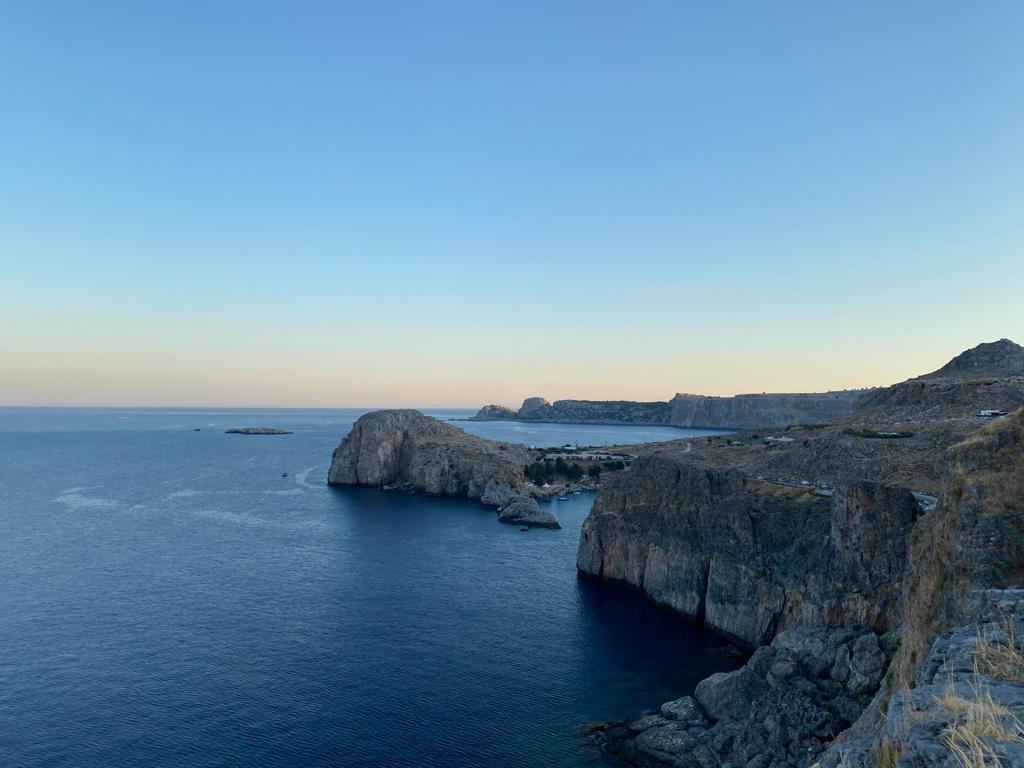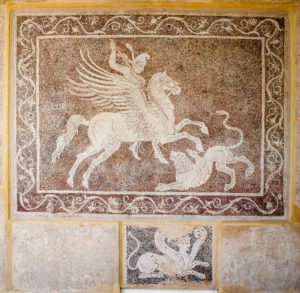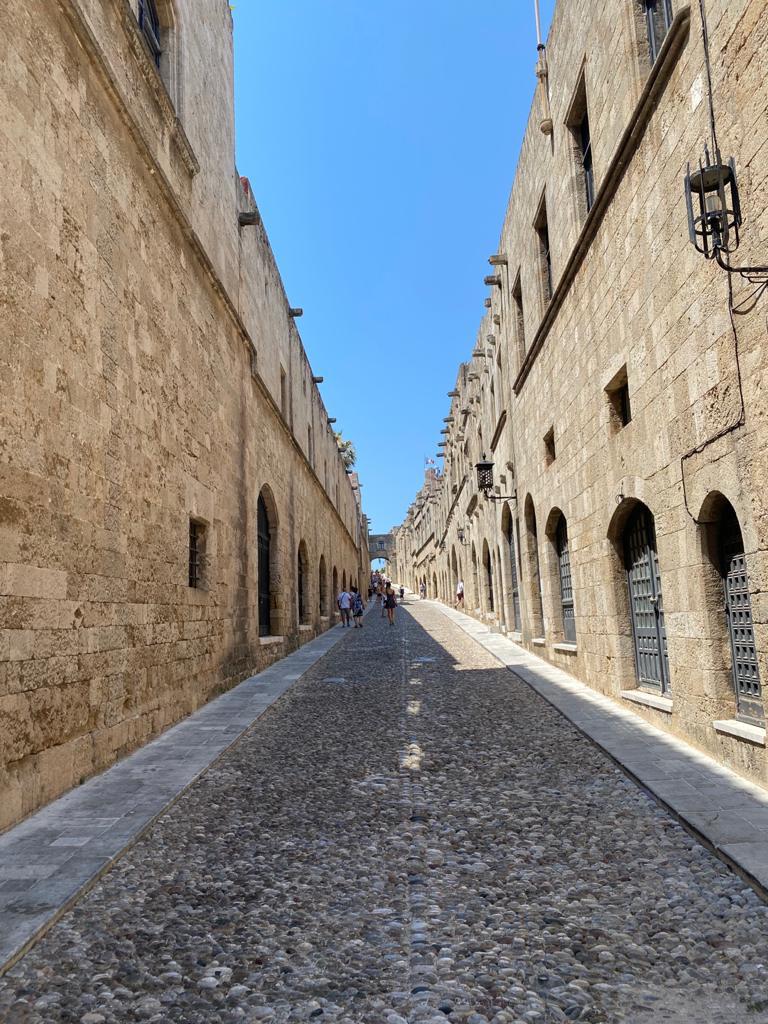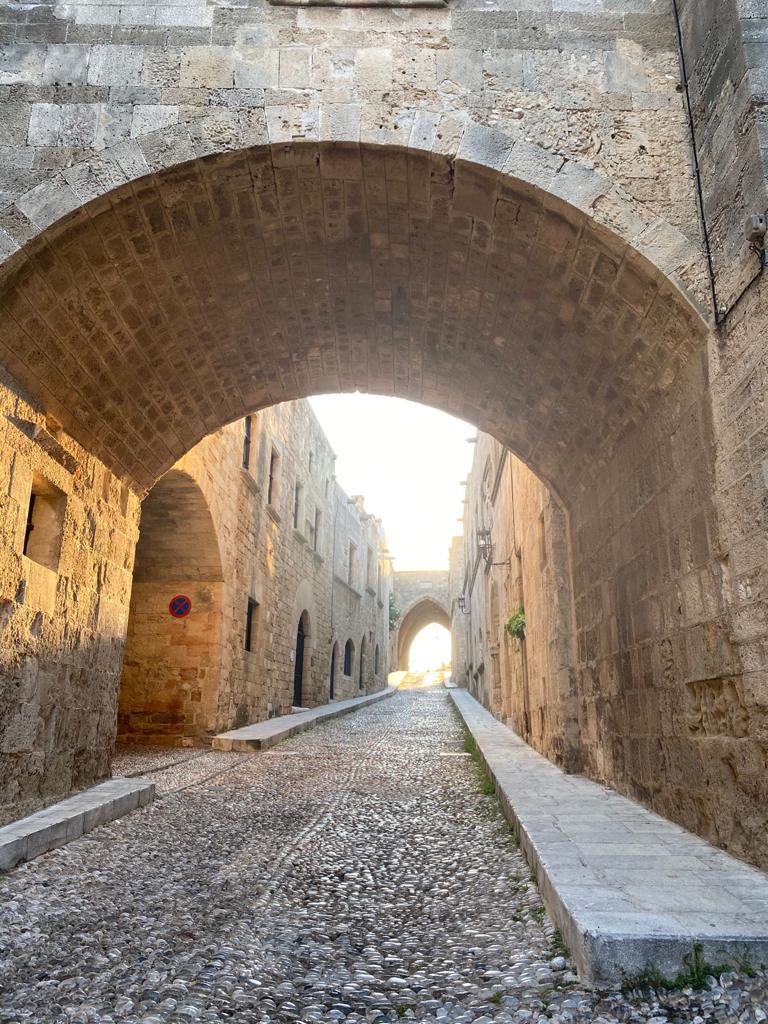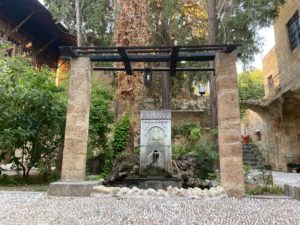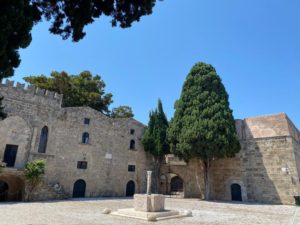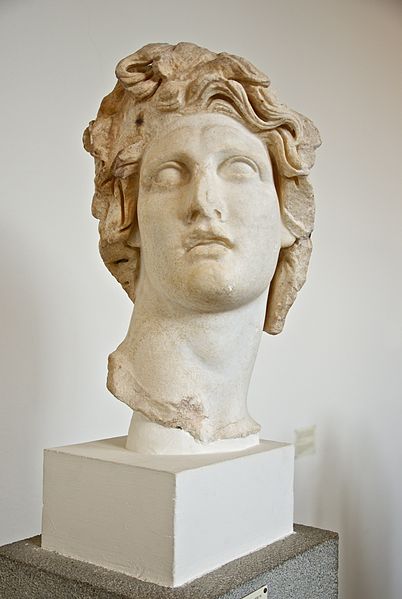
In this post, following the one on Thera, I offer you a safe and virtual journey through time to another Greek island of the Aegean Sea.
Rhodes is well known for its famous statue of the Kolossos of Rhodes, one of the Seven Wonders of the Ancient World, but the Kolossos (the god Helios) was destroyed during an earthquake in c226BCE, and it was not rebuilt according to Strabo.
The best of these are, first, the Colossus of Helius, of which the author of the iambic verse says, “seven times ten cubits in height, the work of Chares the Lindian; but it now lies on the ground, having been thrown down by an earthquake and broken at the knees. In accordance with a certain oracle, the people did not raise it again. This, then, is the most excellent of the votive offerings (at any rate, it is by common agreement one of the Seven Wonders);
Strabo, Geography 14.2.5[1]
The origin of this large island is evoked by Pindar in Olympian 7. A long time ago, Rhodes did not yet exist above the sea; it was hidden under the sea. Meanwhile, as often, the gods were taking an important decision, but one of them was absent. The gods were allotting shares of land among themselves, and as they were dividing the earth they forgot Helios who was not present. Helios, a very powerful god, was not very pleased indeed, and he followed the usual scenario when gods are unhappy: he complained to Zeus. Zeus was going to do a new division of land, but then Helios saw an amazing thing happening…
Here is the passage from Olympian 7:
The ancient stories of men tell [55] that when Zeus and the immortals were dividing the earth among them, Rhodes was not yet visible in the expanse of the sea, but the island was hidden in the salty depths. Helios was absent, and no one marked out a share for him; in fact they left him without any allotment of land, [60] although he was a holy god. And when Helios mentioned it, Zeus was about to order a new casting of lots, but Helios did not allow him. For he said that he himself saw in the gray sea, growing from the bottom, a rich, productive land for men, and a kindly one for flocks. And he bid Lachesis of the golden headband [65] raise her hands right away, and speak, correctly and earnestly, the great oath of the gods, and consent with the son of Cronus that that island, when it had risen into the shining air, should thereafter be his own prize of honor. And the essence of his words was fulfilled and turned out to be true. There grew from the waters of the sea [70] an island, which is held by the birthgiving father of piercing rays, the ruler of fire-breathing horses. And there he once lay with Rhodes, and begat seven sons who inherited from him the wisest minds in the time of earlier men; and of these one begat Cameirus, and Ialysus the eldest, and Lindus. Each had his own separate share of cities [75] in their threefold division of their father’s land, and their dwelling-places were named after them.
Pindar Olympian 7 For Diagoras of Rhodes Boxing-Match 464 B. C., translated by Diane Arnson Svarlien[2]
So Rhodes emerged from the salty sea and became the island of the god Helios, in contrast to Thera where we have an island that disappears into the salty sea. So one island is born and another one vanishes.
Are there different myths concerning the birth or creation of the isle? Maybe, but Pindar’s celebration of the island is lovely, as he writes “….And now, with the music of flute and lyre alike I have come to land …singing the sea-child of Aphrodite and bride of Helios, Rhodes, ”
The Ode mentions three cities, Lindos, Ialysos, and Kameiros, on the island of Rhodes. (The city of Rhodes was founded much later at the end of the 5th century BCE: see below.)
The island of Rhodes and its three cities are also mentioned in Homeric poetry, in the Catalogue of Ships in Iliad 2 in the Sourcebook and also and in Gregory Nagy’s Commentary on this passage[3].
The troops cited in the passage come from the three cities that were Dorians, after the arrival of the son of Herakles.
Tlepolemos, son of Hēraklēs, a man both brave and large of stature, brought nine ships of lordly warriors from Rhodes. [655] These dwelt in Rhodes which is divided among the three cities of Lindos, Ialysos, and Kameiros, that lies upon the chalk.
These were commanded by Tlepolemos, son of mighty Hēraklēs and born of Astyochea, whom he had carried off from Ephyra, on the river Selleis, [660] after destroying many cities of valiant warriors. When Tlepolemos grew up, he killed his father’s uncle Likymnios, scion of Arēs, who had been a famous warrior in his time, but was then grown old. Then he built himself a fleet, gathered a great following, [665] and fled beyond the sea [pontos], for he was menaced by the other sons and grandsons of Hēraklēs. After a voyage during which he suffered great hardship, he came as a wanderer to Rhodes, where the people divided into three communities, according to their tribes, and were dearly loved by Zeus, the lord of gods and men; [670] wherefore the son of Kronos who is lord over all gods and all men, showered down great riches upon them.Iliad 2.653–670, Sourcebook
What happened to the son of Herakles who inhabited Rhodes? Tlepolemos was killed by Sarpedon in Iliad 5.660.
Nagy in his Iliad Commentary ( I.01.463) mentions the differences of the languages spoken in the Greek islands or coastal Asia Minor, and points out that “The Dorian speakers of Doric inhabited the southern part together with outlying islands like Rhodes.”
Nagy also explains later in the Commentary (I.02.655–672) that it signals the colonization of cities. He also indicates that the division of Rhodes into three cities is comparable to the division of Dorian cities into three phūlai, ‘subdivisions’:
{I.02.653–670} We see here the earliest attestation of a reference to ktisis-poetry, which is a special form of poetry centering on the colonization of daughter-cities by mother-cities. [[GN 2016.06.30 via BA 140.]]…
{I.02.668} The tripartition of the whole island of Rhodes kata-phūladon ‘by way of subdivision’ is comparable to the traditional tripartition of many Dorian cities into three phūlai ‘subdivisions’. In Dorian societies comprised of three phūlai, kings are conventionally chosen from the second phūlē. Similarly in Indic traditions, kings are conventionally chosen from the second varṇa- or ‘subdivision’ of society. [[GN 2016.06.30 via GMP 285.]]
Strabo (14.2.6) also tells us that the people of Rhodes are Dorians, which is normal since the island was inhabited by Heracleidae. Furthermore Strabo remarks that the Rhodians were the first to work iron and brass, and made the scythe for Cronus (14.2.7). Maybe other myths exist about this?
The city at the time of Pericles was founded by the same architect, who built the Peiraeus, Hippodamus of Miletus. (Strabo. 9.1 note 35).
The Rhodians were good sailors, were wealthy, and founded many cities. Was Rhodes part of the Minoan Thalassocratie?
Many renowned men were from Rhodes, among them: Hieronymus, Peisander, Simmias the grammarian but Apollonius, who was called Apollonius of Rhodes was not (14.2.13).
The most amazing legend about Rhodes is the story about Helen’s voyage and visit there, at Tlepolemos’ widow’s palace.
According to Pausanias:
…they say that Menelaos and Helen were buried here. The account of the Rhodians is different. They say that when Menelaos was dead, and Orestes still a wanderer, Helen was driven out by Nikostratos and Megapenthes and came to Rhodes, where she had a friend in Polyxo,{3.19.10} the wife of Tlepolemos. For Polyxo, they say, was an Argive by descent, and when she was already married to Tlepolemos shared his flight to Rhodes. At the time she was queen of the island, having been left with an orphan boy. They say that this Polyxo desired to avenge the death of Tlepolemos on Helen, now that she had her in her power. So she sent against her when she was bathing handmaidens dressed up as Furies, who seized Helen and hanged her on a tree, and for this reason the Rhodians have a sanctuary of Helen of the Tree.
Pausanias Description of Greece 3.19.9–10 (Jones/Nagy)[4]
A story about Helen being suspended on a tree in Rhodes! What a strange legend! Could it come from a tradition of hanging images of women on trees as a ritual, as some suggest?
Bettany Hughes[5] adds that she was honored there as “Helen Dendritis, Helen of the Trees,” and that maybe she was a vegetation deity without any connection to war and politics. But in Rhodes there is also a stone from the 2nd century BCE showing one inscription about gifts given by Menelaos and Helen as distinguished and wealthy generous guests. So, we see two different versions about Helen in Rhodes.
Herakles also visited Rhodes before his son. Interesting point: after his visit, when the hero was offered sacrifices they included curses, as mentioned by Apollodorus.
And traversing Asia he put in to Thermydrae, the harbor of the Lindians. And having loosed one of the bullocks from the cart of a cowherd, he sacrificed it and feasted. But the cowherd, unable to protect himself, stood on a certain mountain and cursed. Wherefore to this day, when they sacrifice to Hercules, they do it with curses.
Apollodorus The Library 2.5.11, translated by J.G. Frazer[6]
(Footnote 10 of Frazer’s translation of this passage states: “Lindus was one of the chief cities of Rhodes.”)
The myths about Rhodes are numerous; however, several questions remain. Was Rhodes part of the Minoan Thalassocracy? Was Rhodes powerful during the Mycenaean era?
Kirk, in his Iliad Commentary[7], suggests that the Dorians arrived around 900 BCE, and that they were members of the Dorian Hexapolis. The Hexapolis, mentioned by Herodotus (1.144) is a confederation of six Dorian cities. Kirk also adds that a few Mycenaean artifacts, and a Mycenaean cemetery, were found in Rhodes.
At the Archaeological Museum of Rhodes there is a beautiful mosaic of Bellerophon killing the Chimaera, dated 3rd century BCE. Even if Bellerophon did not kill the Chimaera in Rhodes, I included an image of the mosaic in this post, since it is at the Museum in Rhodes, and it shows another hero accomplishing a labor.
The city of Rhodes now is a famous tourist spot for its medieval old city. The city was occupied by the Order of St John for more than two centuries. The city is part of the UNESCO World Heritage. It is strikingly beautiful, a real medieval gem.
Notes
[1] Strabo. ed. H. L. Jones. 1924. The Geography of Strabo. Cambridge, Mass.: Harvard University Press; London: William Heinemann, Ltd. On Perseus.
[2] Odes. Pindar. Diane Arnson Svarlien. 1990. On Perseus..
[3] Sourcebook: The Ancient Greek Hero in 24 Hours Sourcebook of Original Greek Texts Translated into English, Gregory Nagy, General Editor. 2020-07-17. Available online at the Center for Hellenic Studies.
https://nrs.harvard.edu/urn-3:hul.ebook:CHS_NagyG_ed.Sourcebook_H24H.2013-
Nagy, Gregory. 2017. “A sampling of comments on the Iliad and Odyssey”
https://nrs.harvard.edu/urn-3:hlnc.essay:Nagy.A_Sampling_of_Comments_on_the_Iliad_and_Odyssey.2017
[4] Pausanias Description of Greece. A Pausanias Reader: Translation based on the original rendering by W. H. S. Jones, 1918 (Scroll 2 with H.A. Ormerod), containing some of the footnotes of Jones. The translation is edited, with revisions, by Gregory Nagy.
[5] Hughes, B. 2006. Helen of Troy, Epub ISBN 9781446419144, Pimlico.
[6] Apollodorus, The Library, with an English Translation by Sir James George Frazer, F.B.A., F.R.S. in 2 Volumes. Cambridge, MA, Harvard University Press; London, William Heinemann Ltd. 1921. Includes Frazer’s notes. On Perseus.
[7] Kirk, G.S. 2001. The Iliad: A Commentary Volume One. Cambridge University Press.
Texts accessed September 2020.
Image credits
Head of Helios, public domain via Wikimedia Commons.
Bernard Gagnon (photo) Panoramic view of the archaeological site of Kameiros in Rhodes. Creative Commons CC-BY-SA 1.0. via Wikimedia Commons.
Szilas (photo). Mosaic of Bellerophon killing the Chimaera. Public domain, via Wikimedia Commons.
Remaining photographs, credit: Colombine, Kosmos Media Library
Images accessed September 2020.
___
Hélène Emeriaud is a HeroesX Team member. She studied ancient Greek at school in France and for several years at the University of Minnesota. She holds a degree in Education from Montreal University, and a Master of Education from McGill University. She is an active participant and member of the Editorial Team in the Kosmos Society with a particular interest in ancient Greek and Latin language learning.

